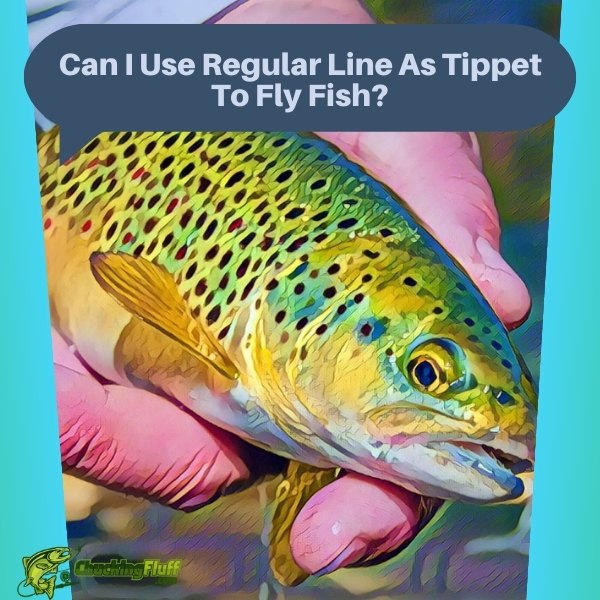| Disclosure: Just to be open and honest the buttons and links you click on in the website will in most cases take you to another website where you can purchase the products I am reviewing. As an Amazon Associate I earn from qualifying purchases. |
Can I Use Regular Line As Tippet To Fly Fish?
Quick Post Navigation
Introduction to Using Regular Line as Tippet for Fly Fishing
In the realm of fly fishing, every angler seeks the perfect setup to entice their elusive prey. Among the essential components of this setup is the tippet—a slender, transparent fishing line that connects the leader to the fly. But what if you find yourself without a tippet? Can you substitute it with your regular fishing line? Let’s delve into this question and explore the nuances of using regular line as tippet for fly fishing.
What is Tippet in Fly Fishing?
Before diving into the intricacies of using regular line as tippet, let’s establish a foundational understanding of what tippet entails. In fly fishing, the tippet serves as the final section of the leader—the tapered length of line that extends from the fly line to the fly itself. Tippet material is typically thinner and more supple than the leader, allowing for a more natural presentation of the fly to the fish.
Importance of Tippet in Fly Fishing
The significance of the tippet cannot be overstated in the pursuit of wary trout and other species. Its transparent nature minimizes visibility underwater, preventing fish from being spooked by the presence of the line. Additionally, the tippet’s flexibility enhances the movement of the fly, mimicking the natural behavior of insects on the water’s surface.
Can You Use Regular Line as Tippet?
Understanding the Difference Between Regular Line and Tippet
While both regular fishing line and tippet serve the purpose of connecting the leader to the fly, they possess distinct characteristics. Tippet material is specifically designed for fly fishing, offering superior knot strength, suppleness, and low visibility. In contrast, regular fishing line may lack these qualities, potentially compromising the presentation and effectiveness of the fly.
Pros and Cons of Using Regular Line as Tippet
Using regular fishing line as a substitute for tippet comes with its own set of advantages and drawbacks. On one hand, it may serve as a makeshift solution in situations where tippet is unavailable. However, regular line may lack the necessary properties to achieve optimal performance in fly fishing scenarios, leading to decreased catch rates and frustration on the water.
- Convenient for You: tippet line holder keeps the tappet spools in order, easy to fetch, accommodates up to 5 tippet spools. The black anodized aluminum rod inside the holder, light weight, is corrosion resistant. With built-in elastic rope and loop, strong elasticity, easy to stretch, can be attached to any fishing vests.
- Length: 30M/33Yds
- Package: 3X, 4X, 5X, 6X tippet lines with tippet line spool holder
- Material: made of clear nylon, fishing tippet line high strength and light weight, is easy to replace.
- Service: SF, dedicated to provide best quality and service for anglers who love fishing, has specialized in fishing tackle supplies 10 years. Any question, please feel free to contact us. We are honorable to support you.
Factors to Consider
Fly Fishing Conditions
The decision to use regular line as tippet hinges on various factors, including the prevailing fishing conditions. In calm, clear waters with minimal current, the visibility of the line becomes paramount, making specialized tippet material the preferred choice. Conversely, in turbid or fast-flowing streams, where visibility is less of a concern, using regular line as tippet may be a viable option.
Types of Fish Being Targeted
The species of fish being targeted also play a crucial role in determining whether regular line can effectively substitute for tippet. While smaller, less discerning fish may be more forgiving of the presence of regular line, selective species such as trout may be deterred by its visibility, necessitating the use of specialized tippet material for success.
Casting Techniques
Another factor to consider is the angler’s casting technique and proficiency. Novice anglers or those still mastering the art of fly casting may find that using regular line as tippet exacerbates casting difficulties, resulting in tangles and missed opportunities. Conversely, experienced anglers with refined casting skills may be better equipped to mitigate the limitations of using regular line as tippet.
- Fly Fishing Tippet: RIO's newest tippet material is an ultra-strong, 100% fluorocarbon with exceptionally high tensile strength. The material is very easy to tie knots in, with high knot strength and a smooth finish that ensures knots seat easily and tightly.
- Trout Fishing Leader: The high break strength to diameter ratio makes this a fantastic fluorocarbon for the trout fly fisher.
- Half Sizes: RIO is proud to introduce "half sizes" of core trout diameters, giving anglers an extra choice when faced with the decision to choose between, say 4X and 5X. Our new 6.5X, 5.5X and 4.5X sizes will make those decisions easier.
- 30 Yard Spools: Each spool has 30 yards of top quality material spooled on, though for those who use a lot of fluoro, our Guide spools each have 100 yards spooled on.
- Target Species: The RIO fly fishing leader is designed for trout fishing, and other freshwater applications. Ideal for dry flies, soft hackles, and nymphs.
How to Use Regular Line as Tippet
Step-by-Step Guide
If circumstances dictate the use of regular line as tippet, follow these steps to maximize your chances of success:
- Select the appropriate pound-test line: Choose a regular fishing line that closely matches the diameter and strength of traditional tippet material.
- Trim the line to length: Cut a length of regular line to serve as your tippet, ensuring it is slightly longer than the desired final length.
- Attach the regular line to the leader: Use a suitable knot, such as the improved clinch knot or surgeon’s knot, to secure the regular line to the end of the leader.
- Test the knot: Conduct a thorough inspection of the knot to ensure it is secure and will withstand the forces exerted during casting and fighting fish.
Tips for Success
- Use lighter pound-test line: Opt for lighter regular line to minimize visibility and enhance presentation.
- Apply floatant: Treat the regular line with a floatant to keep it riding high on the water’s surface, reducing drag and improving drift.
- Monitor for wear and tear: Regularly inspect the regular line for signs of abrasion or damage, as these can compromise its strength and effectiveness.
Common Mistakes to Avoid
- Overlooking visibility: Underestimate the importance of line visibility, potentially spooking wary fish.
- Neglecting knot strength: Use inadequate knots or fail to properly cinch them down, leading to knot failure at critical moments.
- Ignoring line management: Allow the regular line to become tangled or looped, impeding casting and presentation.
Alternatives to Using Regular Line as Tippet
Traditional Tippet Materials
For anglers seeking a more reliable and specialized solution, traditional tippet materials such as monofilament, fluorocarbon, and nylon offer superior performance and versatility. These materials are specifically engineered for fly fishing, providing optimal knot strength, low visibility, and superior abrasion resistance.
Specialized Tippet Lines
In addition to traditional tippet materials, anglers may also explore specialized tippet lines tailored to specific fishing scenarios. These lines often feature advanced coatings, tapered designs, and innovative technologies to enhance casting distance, accuracy, and presentation.
- Sold with one spool each of 2X, 3X, 4X, 5X and 6X Powerflex tippet
- Secure, spring-loaded pull for access to change spools
- Rotatable razorblade line cutter
Conclusion
In the realm of fly fishing, the quest for the perfect setup is a perpetual pursuit. While using regular line as tippet may offer a temporary solution in certain situations, it cannot fully replicate the performance and benefits of traditional tippet materials. Anglers must carefully consider the fishing conditions, target species, and casting proficiency before deciding whether to utilize regular line as tippet.
FAQs
Q) Can I use regular monofilament fishing line as tippet for fly fishing?
A) While it is possible to use regular monofilament fishing line as tippet, specialized tippet materials offer superior performance and are recommended for optimal results.
Q) What pound-test line should I use as tippet for fly fishing?
A) The pound-test line used as tippet should closely match the diameter and strength of traditional tippet material, typically ranging from 2X to 6X for trout fishing.
Q) Does using regular line as tippet affect fly presentation?
A) Yes, using regular line as tippet can impact fly presentation, as it may lack the suppleness and low visibility of specialized tippet materials, potentially reducing catch rates.
Q) Can I treat regular line with floatant to improve its performance?
A) Yes, applying floatant to regular line can help keep it riding high on the water’s surface, reducing drag and improving drift during fly presentation.
Q) Are there any downsides to using regular line as tippet?
A) Yes, using regular line as tippet may result in decreased knot strength, visibility, and overall performance compared to specialized tippet materials.
“Check out some of our other Buying Guides”
Last update on 2025-06-19 / Affiliate links / Images from Amazon Product Advertising API
This product presentation was made with AAWP plugin.






